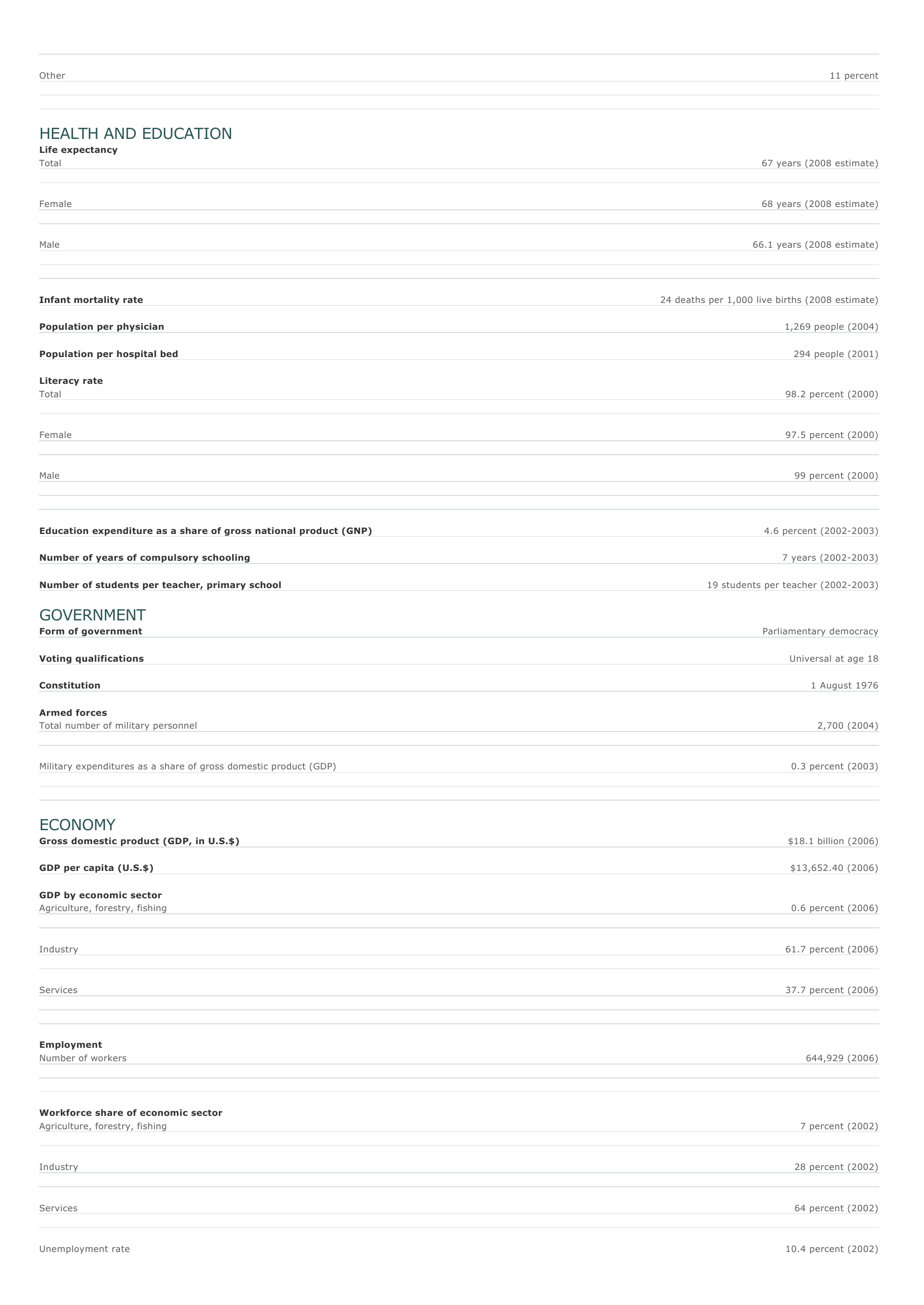Trinidad and Tobago Facts and Figures. BASIC FACTS Official name Capital Area Republic of Trinidad and Tobago Port-of-Spain 5,128 sq km 1,980 sq mi PEOPLE Population 1,047,366 (2008 estimate) Population growth Population growth rate -0.89 percent (2008 estimate) Projected population in 2025 881,713 (2025 estimate) Projected population in 2050 622,011 (2050 estimate) Population density 204 persons per sq km (2008 estimate) 529 persons per sq mi (2008 estimate) Urban/rural distribution Share urban 76 percent (2005 estimate) Share rural 24 percent (2005 estimate) Largest cities, with population San Fernando Port-of-Spain 55,784 (1995) 55,000 (2003 estimate) Ethnic groups East Indian 40.3 percent African 39.6 percent Mixed 18.5 percent White 0.6 percent Chinese 0.4 percent O ther 0.6 percent Languages English (official), Hindi, French, Spanish, Chinese Religious affiliations Roman Catholic 30 percent Hindu 25 percent Protestant 14 percent Anglican 12 percent Muslim 6 percent Nonreligious 2 percent O ther 11 percent HEALTH AND EDUCATION Life expectancy Total 67 years (2008 estimate) Female 68 years (2008 estimate) Male Infant mortality rate Population per physician Population per hospital bed 66.1 years (2008 estimate) 24 deaths per 1,000 live births (2008 estimate) 1,269 people (2004) 294 people (2001) Literacy rate Total 98.2 percent (2000) Female 97.5 percent (2000) Male Education expenditure as a share of gross national product (GNP) Number of years of compulsory schooling Number of students per teacher, primary school 99 percent (2000) 4.6 percent (2002-2003) 7 years (2002-2003) 19 students per teacher (2002-2003) GOVERNMENT Form of government Parliamentary democracy Voting qualifications Universal at age 18 Constitution Armed forces Total number of military personnel Military expenditures as a share of gross domestic product (GDP) 1 August 1976 2,700 (2004) 0.3 percent (2003) ECONOMY Gross domestic product (GDP, in U.S.$) $18.1 billion (2006) GDP per capita (U.S.$) $13,652.40 (2006) GDP by economic sector Agriculture, forestry, fishing 0.6 percent (2006) I ndustry 61.7 percent (2006) Services 37.7 percent (2006) Employment Number of workers Workforce share of economic sector Agriculture, forestry, fishing 644,929 (2006) 7 percent (2002) I ndustry 28 percent (2002) Services 64 percent (2002) Unemployment rate 10.4 percent (2002) National budget (U.S.$) Total revenue $3,004 million (2004) Total expenditure $3,473 million (2004) Monetary unit 1 Trinidad and Tobago dollar (TT$), consisting of 100 cents Major trade partners for exports United States, Jamaica, France, Barbados, and Canada Major trade partners for imports United States, Venezuela, Colombia, Germany, and United Kingdom ENERGY, COMMUNICATIONS, AND TRANSPORTATION Electricity production Electricity from thermal sources 99.59 percent (2003 estimate) Electricity from hydroelectric sources 0 percent (2003 estimate) Electricity from nuclear sources 0 percent (2003 estimate) Electricity from geothermal, solar, and wind sources 0.41 percent (2003 estimate) Number of radios per 1,000 people 533 (1997) Number of telephones per 1,000 people 248 (2005) Number of televisions per 1,000 people 405 (2000 estimate) Number of Internet hosts per 10,000 people 61 (2003) Daily newspaper circulation per 1,000 people 121 (1996) Number of motor vehicles per 1,000 people 113 (1997) Paved road as a share of total roads 51 percent (1999) SOURCES Basic Facts and People sections Area data are from the statistical bureaus of individual countries. Population, population growth rate, and population projections are from the United States Census Bureau, International Programs Center, International Data Base (IDB) (www.census.gov). Urban and rural population data are from the Food and Agriculture Organization (FAO) of the United Nations (UN), FAOSTAT database (www.fao.org). Largest cities population data and political divisions data are from the statistical bureaus of individual countries. Ethnic divisions and religion data are largely from the latest Central Intelligence Agency (CIA) World Factbook and from various country censuses and reports. Language data are largely from the Ethnologue, Languages of the World, Summer Institute of Linguistics International (www.sil.org). Health and Education section Life expectancy and infant mortality data are from the United States Census Bureau, International Programs Center, International database (IDB) (www.census.gov). Population per physician and population per hospital bed data are from the World Health Organization (WHO) (www.who.int). Education data are from the United Nations Educational, Scientific and Cultural Organization (UNESCO) database (www.unesco.org). Government section Government, independence, legislature, constitution, highest court, and voting qualifications data are largely from various government Web sites, the latest Europa World Yearbook, and the latest Central Intelligence Agency (CIA) World Factbook. The armed forces data is from Military Balance. Economy section Gross domestic product (GDP), GDP per capita, GDP by economic sectors, employment, and national budget data are from the World Bank database (www.worldbank.org). Monetary unit, agriculture, mining, manufacturing, exports, imports, and major trade partner information is from the statistical bureaus of individual countries, latest Europa World Yearbook, and various United Nations and International Monetary Fund (IMF) publications. Energy, Communication, and Transportation section Electricity information is from the Energy Information Administration (EIA) database (www.eia.doe.gov). Radio, telephone, television, and newspaper information is from the United Nations Educational, Scientific and Cultural Organization (UNESCO) database (www.unesco.org). Internet hosts, motor vehicles, and road data are from the World Bank database (www.worldbank.org). Note Figures may not total 100 percent due to rounding. Microsoft ® Encarta ® 2009. © 1993-2008 Microsoft Corporation. All rights reserved.






